You are currently browsing the category archive for the ‘Inspirations’ category.
A summer spent in Spain, in the heart of a national park, removed half an hour drive from any nearest town and shop! It was like a dream. But it wasn’t a dream but a reality! I went to Joya: AiR, an environmental artist residency set in between the ravines of white sedimentary rock walls full of fossils and fields, almond trees, and bee-eaters. Oh boy, I had some space to breathe! I love London, but I was a happy bunny to be away from it.
I was asked to write a little summary of what I did at Joya, at the end of my three weeks there. Here is a little excerpt, please follow up the link to continue reading.
“I’ve flown to Joya: AiR from London with an open mind. I wanted to relax, refresh and escape from my city life. Having done an art residency at Walthamstow Wetlands in London which stores around 40% of the water that will arrive in peoples’ taps after cleaning I wondered, what the landscape could be like in a desert environment? I wanted to know how the land and its’ habitat is affected by the driest spells of Andalusien summer.”
Following two images are taken by Jaron Rowan. Thank you!


Travel portrait/lifestyle photographer Kazumi Sakurai and I enjoying the sun.
With a winter frost and wind, an art commission has landed on my art studio doorstep. I’ve been interested in the water filtration processes since my Walthamstow Wetlands Art residency (2015-2016) and my dream project based on these dynamic systems is now happening!
Wateraid‘s Learning Department approached me at the end of 2017, however, I’ve kept it quiet as things have been developing. Now, after a couple of research visits at Thames Water’s Coppermills Water Treatments Works and at the Royal Air Force museum where the installation will feature during a week-long of events celebrating the 75th anniversary of Dambusters in May 2018, I’m firmly engaged in the process and very excited. To read a blog post about water filtering research visit at Coppermills click here.
WaterAid is a wonderful charity and I’ve learned from them so much about water. This video summarises what they are all about. I’ll be mentioning them in my work in progress posts a lot.
What am I creating?
I’m designing a concept and a sculptural interactive installation based on the principles of a sand dam. I can reveal the installation will carry three conceptual elements (water, concrete wall/dam, and sand/sediments), see the image below.

While I’m creating a physical sculpture and its concept, I wanted to bring another layer of interaction into the RAF museum’s outdoor space. I’ve invited Danny Saul to collaborate with me. Danny Saul is a London-based composer and sound artist whose work explores connections between sound and space, and between (real-world) recorded sounds and synthesized electronic sounds. How very exciting! Welcome, Danny! Learn more about his work on his website.

Composer and sound artist Danny Saul.

Sketchbook insights, ideas for learning and exploring a sand dam.
I’m going to return to sketching to finalize some ideas, but I will share with you more work in progress soon. Thank you for reading this blog post and I’m looking forward to your comments. See you on May 19th between 11am to 3pm at Collindale’s RAF museum during a wonderful Dambusters anniversary week!
#Dambusters75 #legend #legacy #WaterAid #sanddam #RAFmuseum .
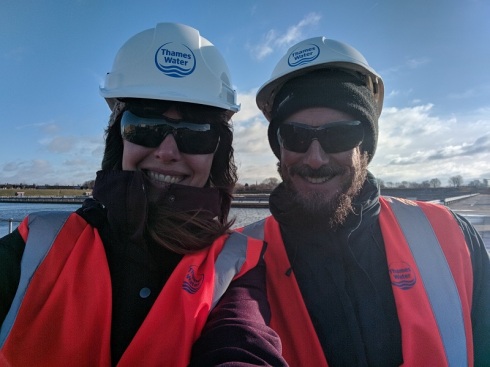
Keith from WaterAid and me at Coppermills Treatments Works Thames Water site, Dec 2017.
In this rather geeky post, I’m sharing what I’ve learned during a research visit at Coppermills Water Treatment Works, Thames Water site, filtering around 30% of London’s drinking water. This secure site has its gates firmly shut to most passers-by (I’ve tried to get in to see what’s going on there before). I feel very special to have been able to go there this time! I need to say a big thank you to Deena from Thames Water and Keith from WaterAid to grant me access to the site, on which they both accompanied me in December 2017.
There are several stages of water filtration, here I share some knowledge learned during our research trip at the Coppermills Water Treatment Works.
Rapid gravity filters trigger the cycle of the filtering. The whole process lasts 12 hours from start to finish, and then it continues to water service reservoirs. Rapid gravity filters are large open top tanks of passing water. Any big particles such as grass, feathers and other bits that haven’t been stopped by grids on their way from Thames Water reservoirs to Coppermills are removed. This process takes 15 minutes, hence its name, rapid. The rapid gravity filters are maintained by reverse flashing the water flow upwards and the large particles are directed and diverted out of the filter where they are caught and removed.
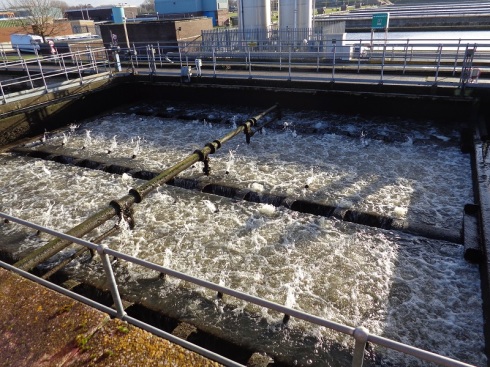
Rapid Gravity Filters at Coppermills.
Ozone gas is added at the second stage of filtering and it is injected into the water to remove pesticides and organic material. The process of ozonization has antibacterial properties and the water leaves in two separate streams and is directed to, for me the most interesting stage of water filtration, Slow Sand Filtration.
Slow Sand Filtration works on large-scale filter beds. There are over 33 slow sand filter beds at the Coppermills site. It was fascinating to watch how the workers immaculately layered the sand in one of the filter beds and sitting in a large vehicle leveled the elements. The birds try to help too, leaving their mark.
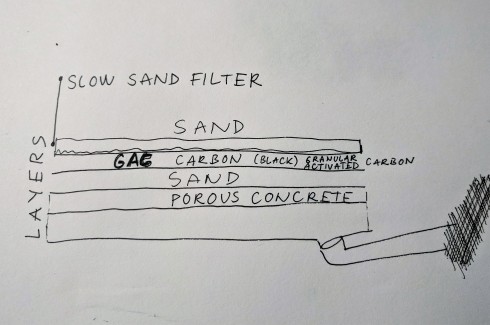
Sketch of a slow sand filter, S Krupinska 2018.
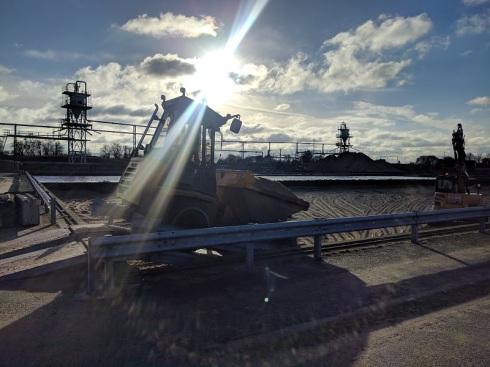
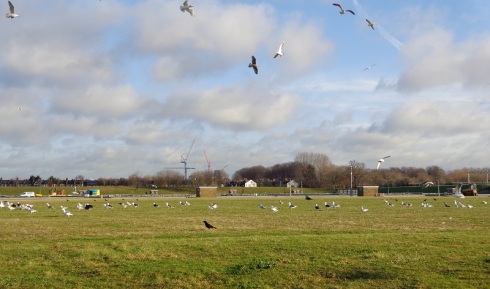
After the water passes through very fine, around 400-micron stainless steel mesh screens (2×3 m large), it heads for about 3 hours to the final disinfection area. My words couldn’t describe this process better than the explanation on Thames Water website: “Chlorine is dosed at the end of treatment before the water is sent into supply to destroy harmful micro-organisms. The disinfection process is performed in specially designed contact tanks, which contain a series of baffles. The tanks ensure that the chlorine remains in good contact with the water for a set amount of time, to ensure effective disinfection before it is sent into the distribution network.”
The water after this stage is sent to service reservoirs, each area has their own enclosed water storage facility. I’ve investigated where is my nearest Service Pumping Station. I found it in Streatham. The following link takes you to it.
Why am I researching this topic and what am I working on? Learn about my big project coming up in a museum in May 2018 here.
Thank you very much for reading this blog post. See you soon.
Hello nature, art, and outdoor enthusiasts! I’m doing a walk in Walthamstow Wetlands on Sunday 20th November, at 12-2pm. Book your free ticket here.
The walk is happening in conjunction with a sculptural installation Floating Reedbed in Tracing Wastelands group exhibition (The Depot Clapton). The exhibition evolved through a collaboration between MA Art and Science at Central Saint Martins, and the Government Office for Science. This walk is kindly supported by London Wildlife Trust’s Lead Community Engagement Volunteer Stephen Ayers.

Credits: Steel, plaster, paint or Floating Reedbed (2016) by Silvia Krupinska
Arrive 11.50am – 12.00pm. Meeting at the Ferry Lane entrance to the reservoirs opposite the Ferry Boat Inn, outside the Thames Water Rangers’ office. Nearest tube station is Tottenham Hale and Blackhorse Road. It is about 7 min walk from both stations. Buses are available. (Please note you must book a free ticket as places are limited. Thank you.)
Start 12.00pm
Walk through Walthamstow Wetlands
Finish 2.00pm (and then you can join me to see the exhibition after, if you like :).
*Adults only as the site is still in development. No dogs allowed except guide dogs and assistance dogs. If you wish to extend your visit after our official time (12-2pm) you will need to purchase a day birdwatcher’s pass £1 from the Ranger’s Office. (Cash only) The places on the walk are strictly available only by booking a free ticket. On the occasion that you no longer can join us and you booked your free ticket, please release the ticket.
Book your free ticket here.
To find out more about the exhibition and its location, follow this link to another blog post. Many thanks, see you soon!
 The first in a series of exhibitions, Tracing Wastelands focuses on the materiality of waste and how human agency plays a vital role in this transition. Teasing out strands of the same chord, the exhibiting artists have investigated scientific, social and cultural perspectives, evolving a range of methodologies to what the concept of waste means, and our responsibility towards it.
The first in a series of exhibitions, Tracing Wastelands focuses on the materiality of waste and how human agency plays a vital role in this transition. Teasing out strands of the same chord, the exhibiting artists have investigated scientific, social and cultural perspectives, evolving a range of methodologies to what the concept of waste means, and our responsibility towards it.
Tracing Wastelands is an exhibition of work, evolved through a collaboration between MA Art and Science, Central Saint Martins, and the Government Office for Science.
Exhibiting artists are:
Julius Colwyn | Silvia Krupinska | Beckie Leach | Hannah Scott | Stephanie Wong | Jennifer Crouch
Curated by: Ellie Armstrong and Julius Colwyn
The Depot, 38 Upper Clapton Road, London, E5 8BQ
18 November – 20 November
Opening Times:
Friday 18th : 6pm-9pm Private View
Saturday 19th : 12-6pm
Sunday 20th : 12-6pm
_ _ _ _ _ _ _ _ _ _ _ _ _ _ _ _ _ _ _ _ _ _ _ _ _ _ _ _ _ _ _ _ _ _
To accompany the exhibition a walk will be taking place in Walthamstow Wetlands led by me. The walk will be focusing on exploring reedbeds and their function, acting as living natural filtration devices and much more. An expert from the field will join us on the day. Free, booking required as space is limited: https://www.eventbrite.com/e/reedbeds-of-walthamstow-wetlands-walk-tickets-29203217610
I was commissioned by Manor House Development Trust to bring one of my art workshops to the Hidden River Festival in London this weekend. The festival is situated beside a spectacular Woodberry Wetlands Reserve and New River, which carries a long stream of history, first dating back to 1613.
Draw with sand and create new rivers workshop grabbed the attention of children and their parents, taking part and learning a new art technique. I bring you some images from the day. We all had lots of fun.
If you would like to include my workshop in your festival or an event, let me know on silviakrupinska(at)gmail(dot)com, and we can discuss it further. Thank you.
Over past months, a lot of exciting has happened. I’ve dived into Walthamstow Wetlands research and met some fantastic people in and outside of my MA Art and Science at CSM. One of which is my valued collaborator Dr Johanne Orchard-Webb, Research Fellow, Lee Valley Team of Hydrocitizenship – arts and humanities project funded by AHRC. It has been a true pleasure to exchange ideas and experiences with Jo. She has written a fantastic post about the ways how our collaboration has developed and what it has entailed so far.
Dr Jo Orchard-Webb wrote:
“While we have used different approaches to exploring ideas around what we call ‘hydrocitizenship’, there is a good deal of common ground in our thematic findings, and this ongoing process of research collaboration has for me highlighted the importance of multi-disciplinary teams working together to explore and understand hydro-social relations.”
To read the full post and find out more, please click on the following link.
Many thanks
‘Fisherman’s Flies’ by Silvia Krupinska. Image taken at Walthamstow Wetlands, on one of the orientation walks organised by London Wildlife Trust.

 Pictures from trip 4 at Walthamstow Wetlands working on The Rivers Project. Apart from the bedeguar gall (the red fluffy thing below), herons were very approachable this time to my surprise. I was thrilled to have used my binoculars for the first time, too! It was truly one of the exceptional days.
Pictures from trip 4 at Walthamstow Wetlands working on The Rivers Project. Apart from the bedeguar gall (the red fluffy thing below), herons were very approachable this time to my surprise. I was thrilled to have used my binoculars for the first time, too! It was truly one of the exceptional days.
Image below: Diplolepis rosae is not a lichen which I thought first. It’s an insect nest. Who would have thought? Read more about it here: https://en.wikipedia.org/wiki/Diplolepis_rosae
“What are you cooking?” My boyfriend asked. “I’m making some berry inks, of course!” I answered.

Cooking the berries and the leaves to extract the colour for the inks. I’ve added a bit of vinegar to stabilize the colour, which might slow down the colour fading too.

Testing of inks and left over pulp on paper
This is a report I wrote for The UAL Postgraduate Community newsletter and blog. You can also read it directly in a slightly edited version here.
I wanted to just get a feel for such a place. My recent, The Rivers Project was my excuse to talk with the brainy scientists and listen to their “foreign” language. I explained why I was there and that I hoped to find a collaborator, to gain an insight to what’s hiding in a riverbed of a river I was studying at the time. When I failed to define a precise reason why I needed the microscopy to help me to progress my work, then I saw an exhibitor from France, a company called Digital Surf. You know that feeling when you can finally visualize your idea? Talking with them, ever so friendly as all the exhibitors, I knew this company might be helpful. We exchanged our business cards and now after a couple of emails, there seems to be a great chance we will collaborate on The Rivers Project with their software. But even, if this doesn’t work out, the approachable attitude of the scientists there and all the thought-provoking chats we had, individually, or the whole group of us from UAL, was definitely worth it!
In olden days, on the last day of April, young unmarried men would raise Maypoles in front of their girlfriends’ houses. If they did this in the 15th century in Germany, it would be considered a law-binding marrying agreement! Thankfully these days the tradition is only an excuse to meet and dance together to celebrate the arrival of spring and female beauty. Many nations have this tradition of elevating a young tree on a long wooden pole, decorated with many colourful ribbons. Check out some great international examples of Maypoles by country. But did you know artists have been making art inspired by maypoles? This tag shows some examples.
May Installation on 10 trees in Empson street E3, London. 22 May 2013
When the ribbons from my outdoor May Installation (above) were stolen in 2013, I knew I wanted to revisit this topic again. A perfect opportunity has arrived. Mira Varg and I (both studying at UAL – CSM, MA Art and Science and are Slovak) proposed to make a May sculpture for a Student May Ball in the Embassy Of the Slovak Republic in London. We were both delighted when the Embassy liked the idea. We enjoyed our collaboration a lot!
We’d like to thank The Embassy Of the Slovak Republic and The Embassy of The Czech Republic for this year’s Students May Ball, which happened last night. So many amazing people turned up, lots of beer was consumed and much traditional food was eaten! And I think I speak for all that attended when I say, we had a great time! I’ll finish off with these images of folk dancing by Morena Dance Company below. Thanks for reading this post and I hope to see you maybe during one of the future events in the Embassy. Take care. S.
FLOWING ROOTS – Metal sculpture and sound piece
Steel might not be the first material to be associated with a river or its flow. I see it differently, as for me it became a medium for a sculpture inspired by a river I grew up nearby in Poprad, Slovakia – the 167.4 km long Poprad River. “She” is for me a kind of symbol representing my roots, my belonging and the natural beauty of the Spiš Region.
This river story starts when I discovered a disaster struck in February 2014. Twenty times more than allowed amount of cyanide was found in the Poprad River’s flow, starting in an industrial area of Matejovce. The poison caused deep damage to the effected ecosystems. Thousands of fish died and the habitat on the seven-kilometre-long stretch will take years to recover. However, and there is a big pause here. I choose not to cry over spilled milk and run around in anger, but I choose in this sculptural installation to celebrate this river-flow, its ongoing splendour and the healing it’s going through. I choose the steel, I choose the lasting strength and I choose to look ahead and show how important she is to me. All rivers deserve attention, admiration and appreciation; this is what my sculpture and the sound piece are about.
I’d like to thank to SLOVENSKÝ VODOHOSPODÁRSKY PODNIK, š. p., Správa povodia Dunajca a Popradu for their support and help with gathering research data and materials about The Poprad River. I hope our collaboration can continue to grow in more future projects!
You can see FLOW sculpture and sound piece and many other artworks by other artists in UAL CSM Interim Exhibition – You’re the Reason Our Kids Are Ugly – works of MA Art and Science, MA Photography and MA Fine Art at The Laundry E8, 2-18 Warburton Road, E8 3FN London, UK.
27th-29th March, 11-5, PV 26th March 6-9pm
https://www.facebook.com/events/1560148757576767/
ourkidsareugly.co.uk
csm.arts.ac.uk
@ourkidsareugly
Walking from a party last night, we came across this London classic suburban evening scenario. A fox and a cat having a quiet but respectful conversation regarding territory, or perhaps a sit down of a perfect harmony? I couldn’t tell from their body language if there was much tension between them, or they were actual friends. One thing is for sure. Both the cat and the fox were tempted to come to us and check us out. Would you stroke a fox?
After eight years since my graduation from the BA Fine Art at Chelsea School of Art and Design in London, I’m returning to study at The University of the Arts London. I’m thrilled to be accepted to the MA Art and Science at Central Saint Martins. I’ve been feeling settled for many years with my BA, having the best times in my studio doing various projects, but somehow this year something has changed, I’ve become even more hungry to learn. It all happened so suddenly, and now I’m a student again, beginning a two year full time MA at the end of September 2014.

For super curious, a virtual tour of CSM here. http://www.arts.ac.uk/csm/about-csm/facilities/virtual-tours/granary/
How do I feel? Well, I’m very excited and terrified at the same time. Do I know how to be at UNI after all this time? Saying that, I’ve a good idea about what I’m interested in and Nathan, our course leader reassured me, it’s very different than being an undergraduate student. We all will be very keen to learn, serious about our art and science path, and we will have lots of opportunities to link and network. I’m very happy about my decision to do this. I can’t wait to meet my 19 class mates now, and explore the art & science angle in my practice!
So my art studio will be moving to a different location. I had been interviewed perhaps for the last time in my long term art studio at Unit 3 this August. Lovely team from online TV skcz.tv wanted to know where my inspirations come from, and they asked me about my transition from Poprad, Slovakia to London in January 1999, when I became a Londoner. I’d like to say a big thank you to SKCZ.TV! The document is in Slovak only, if you don’t speak it but you’re curious about my studio, soon to be moved to CSM, you might like to watch?
Until next time!
S
When I was a girl my younger brother Lubko was in nursery and I would often stay with my grand mother Alzbeta, while our parents were at work . There was a small garden under my granny’s window. I had a lovely time playing in there, picking small flowers and petals. I’d hide them in my secret hiding place, and once the plants were dried and flattened, I’d create petal ladies. Some of the petal dolls were made from freshly picked flowers too. Sometimes I was lucky, and was allowed to pick large ones like tulip tops! This idea and nostalgia are driving my new research into new works. Without revealing any more, I’ve an image for you.
Hello dear followers. This post is from the series of self reflecting and informative posts about my practice and inspirations. Every-now-and-then, I think about how I am as an artists, what has changed and as well as for me but also for my audience, I write down my thoughts. I’ve written about my love of nature and organics in the previous post in this series, Sharing the transition – My love of textures and making is stronger than ever. Today, I’m going to write about my new jewellery brand KAJ – Krupinska Abalone Jewellery.
My creative practice has expanded, when I realized how much I enjoyed making the abalone pendants. I had this kind of material from previous experiments in organic sculpture and drawing. I wrote about it during my residency in March 2013 with Unit 3 Projects artists in DegreeArt in Vyner Street, London. The article is explaining where my ideas at the time came from, about the ethics of my materials and about inspirations for my Mountain Lakes series. The artworks described in the article were also exhibited after the residency in DegreeArt Gallery with 8 other Unit 3 Projects artists’ works, but further on (expanded) in my solo exhibition in Oct. 2013 – Plesa a Fragmenty in Poprad, Slovakia, supported by LivePozitive os.
I have branded my art practice as Organic Sculpture and Art, and KAJ is a more design lead streak in this direction, with also originals and limited editions, but more accessible to anyone wishing to have a piece of organic sculpture, in wearable form. I named KAJ inspired partly on my name and abalone, and partly inspired by a story I used to listen to on the radio or LP, The Snow Queen by H. Ch. Andersen. The boy whose name I admired was called Kaj, the best friend of Gerda. (Listen in Slovak to the story here.) Now I have over 32 KAJ pieces of jewellery listed in my online store krupinskart, along with 20+ of my organic sculptures, prints and other art. (Some works are only available directly from my studio, not listed anywhere. Enquire within.)
I was a bit worried at the beginning I started to make KAJ that it would affect my art and how people would see my artworks, whether I should totally separate it from my art. But now I feel good about it, and my worries are gone, as I feel it made me stronger in my art practice. I’m honest to what I like to make and stand for, and I no longer worry that it will be distracting to me and my audience. I’ve had some great feedback from my collectors of KAJ and collectors of my art and I feel encouraged by it. After my limited edition of 50 abalone pendants if finished, I’m planning to introduce another fairy-tale inspired name of GERDA pieces. But that’s a bit ahead of us, and you’ll here about it later.
Finally I’d like to thank you for learning about my art and following my blog, and if you have anything to say about how you feel I present my work, how I talk and write about it or any feedback you might have, good or bad, I’m happy to read any constructive criticism. I’m aware I’ve plenty to learn, and become better practitioner. Enjoy the spring and lots of love.
Silvia
It’s the time to look at my art practice and rewrite my artist statement. But firstly, very freely, I’d like to share free-handedly this flow of words and ideas with you, my followers. Don’t worry. There won’t be any massive changes. As I grow and learn I gradually realize that the textures I have been relying on and all I love doing, whether it’s sculpting, drawing or even making the KAJ jewellery, all those actions are headed towards one direction. Fully or partially touching on the themes of nature and ecology, geography and history, broadly speaking. My love of textures and making is stronger than ever. I am aware of certain needs I have (not talking of the finance), something that the making alone isn’t covering. I want to stay neutral and non-judgemental in the concepts I use in my art practice, but at the same time mapping out, bringing to attention, describing how I see events, things and our surroundings. Simply bringing these certain issues to visual forms and formats to my audience, presented and translated to my own artistic language – organic sculpture, painting and drawing. Nature and natural forms have always interested me. I want to bring you the issues I care about and I want to make you understand where I (ideologically and geographically) come from.
I need to come out of the ‘cloud’ and be more specific what I’m trying to say. I can do that using a strong example of what happened to me a couple of weeks ago. To be precise, nothing happened to me, but I read a news article about one river that is special to me. River Poprad, in the town (Poprad, Slovakia) where I was born. As if a member of my family died, I read the story with tears in my eyes. The River Poprad was let down. We as its carers and community, we let it down. It had been poisoned! Cyanide penetrated the river and killed all alive in it including some vegetation running along vast 5-7 km. It will take at least 5 years for the river to ‘come back’ to its normality, I’ve learnt from the internet. The poison appeared in the river in the industrial Matejovce near Poprad all the way to and a bit beyond Kezmarok. This incident/crime is one of the reasons why I’m consciously going to focus, zoom in and explore effects of mankind on the planet. I now make the themes of water (lakes, rivers, sea and its shores, ice) as my main source of inspiration.

Detail with Velke Hincovo pleso and River Poprad, abalone drawing. Working title ‘Birth of Rieka Poprad’. With ten mountain lakes and four rivers.
© Silvia Krupinska 2014
I’m planning and developing an important solo exhibition in the Slovak Embassy in London for the next year (April 2015). I’m writing this unofficially, I need to secure the finance and pin down my sponsors and grants first. The theme of the show will be ‘Water’ – the essence of life and wellbeing. As these large projects come, I feel this need to pull my ideas, myself together. Hence maybe the focus in my art has been shifting from only making, enjoying and sharing my creations to also adding stronger conceptual message to them – with the ecological undertone.
I think these four paragraphs are enough. I hope I clarified my intentions and aims for the future, if not fully than at least partly and I sincerely believe that the coming years are going to be the best so far! On this optimistic note I end my blog post. I can’t thank you enough for reading it and supporting me and my artistic practice by visiting my blog. I need lots more time to think, I need lots more advice to become a better artist I’m today. I would love any feedback, advice you might want to give me. If you feel you would like to support me and my upcoming exhibition in April 2015 (when I turn 35 oh gosh!) then please don’t hesitate to contact me or even have a look at my online store, where I offer some small to medium artworks and KAJ jewellery, or make an appointment to visit my studio to see the works in person. I’d be ever so grateful.
Thank you
Silvia























































